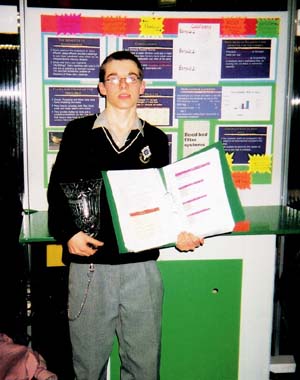| 2004 |

|
YEAR BOOK |
St Kieran's College, Kilkenny
|
The effects of slurry reed beds on the environment
|

Reed beds consist of four ponds filled with wetland plants. Reeds catalyse the breakdown of slurry effluent, silage effluent and dairy washings to give clean unpolluted water which can be released directly into our streams. Reed beds bind carbon in the soil and return nitrogen in the waste to the atmosphere as gas.
I examined water samples from reed beds in my local area. They deal with huge amounts of run-off water, which would be high in nitrates and phosphates, which could potentially cause eutrophication. The reed bed lowered the Biological Oxygen Demand of the water significantly, and therefore it will not produce this excessive algae growth. According to farmers, it takes a lot of pressure off the slurry tanker processing farmyard waste. Time and expense are saved as no spreading is necessary, there are no running costs, and no labour or machinery required. I also discovered that the reed beds provided a habitat for wild life such as pheasants, water hens and grouse. Some South-East factories that incorporate them have fish and wildlife inhabiting the last bed, including trout, a pollution sensitive fish.
I tested the level of water pollution entering and leaving each reed bed. The amount of solids fell from 2060 mg/l to 10mg/l. The colour of the water in the first reed bed was brown and green but, at the point of discharge, it was crystal clear. The pH changed from slightly alkaline to neutral. The coliform count, which analyses faecal bacteria numbers, was also significantly reduced, showing these beds can accomplish complete purification.
My results clearly showed that use of the reed beds proved successful and considerably more environmentally friendly than the spreading of effluent onto land. While the reed beds are very effective for the filtration of liquid effluent, they are not suitable for the treatment of solid slurry. This type of slurry has a very high nutrient content and it would be absorbed by the reeds instead of returning nutrients to the soil.
Niall Quinlan won second prize in the Junior Individual Section in the Biological and Ecological Sciences Category at the EsatBT Young Scientist & Technology Exhibition in January 2004. He also won a Special Award sponsored by the Environmental Protection Agency. His teacher was Ms Eileen Hanrick.
| This article was sponsored by the Environmental Protection Agency |
|---|